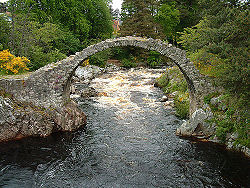
Muckle Spate (1829)
Encyclopedia
The Muckle Spate was a great flood in August 1829, which devastated much of Strathspey
, in the north east of Scotland.
It began raining on the evening of 2 August 1829, and continued into the next day when a thunderstorm
broke over the Cairngorms
. To the south, the River Dee
rose rapidly above its normal level - 15 ft (4.6 m) in places (27ft at Banchory). The Rivers Nairn
, Findhorn
, Lossie
and Spey
were affected, to the north.
 As well as flooding, many bridges were washed away, including those over the Linn of Dee and Linn of Quoich
As well as flooding, many bridges were washed away, including those over the Linn of Dee and Linn of Quoich
. The original Mar Lodge
was affected. Carrbridge
's most famous landmark, the old bridge, built in 1707, from which the village is named was severely damaged and left in the condition we see today. Homes were lost in Kingston, Moray
, a small village on the Moray Firth coast, at the mouth of the River Spey. In Forres
, five Findhorn
fishing boats rescued residents.
The Muckle Spate is remembered in a poem of the same name by David Grant, written circa 1851, describing the effect on the parish of Strachan.
Strathspey, Scotland
Strathspey is the area around the strath of the River Spey, Scotland, in both the Moray council area and the Badenoch and Strathspey committee area of Highland....
, in the north east of Scotland.
It began raining on the evening of 2 August 1829, and continued into the next day when a thunderstorm
Thunderstorm
A thunderstorm, also known as an electrical storm, a lightning storm, thundershower or simply a storm is a form of weather characterized by the presence of lightning and its acoustic effect on the Earth's atmosphere known as thunder. The meteorologically assigned cloud type associated with the...
broke over the Cairngorms
Cairngorms
The Cairngorms are a mountain range in the eastern Highlands of Scotland closely associated with the mountain of the same name - Cairn Gorm.-Name:...
. To the south, the River Dee
River Dee, Aberdeenshire
The River Dee is a river in Aberdeenshire, Scotland. It rises in the Cairngorms and flows through Strathdee to reach the North Sea at Aberdeen...
rose rapidly above its normal level - 15 ft (4.6 m) in places (27ft at Banchory). The Rivers Nairn
River Nairn
The River Nairn is a river in the Scottish Highlands which rises in the Monadhliath Mountains and flows northeast through Strathnairn to enter the Moray Firth at Nairn. The headwaters of the Nairn, the Allt Mor and Cròm-allt Beag drop steeply down the western slopes of Carn Ghriogair, their...
, Findhorn
River Findhorn
The River Findhorn is one of the longest rivers in Scotland. Located in the north east, it flows into the Moray Firth on the north coast. It has one of the largest non-firth estuaries in Scotland....
, Lossie
River Lossie
The River Lossie is a river in north east Scotland. Ptolemy , the Greco / Roman geographer, named it as ost. Loxa Fl. The river originates in the hills above Dallas, in Moray, and has its source 400 meters above sea-level. It enters the sea at Lossiemouth on the Moray Firth...
and Spey
River Spey
The River Spey is a river in the northeast of Scotland, the second longest and the fastest-flowing river in Scotland...
were affected, to the north.
Damage

Linn of Quoich
-References:...
. The original Mar Lodge
Mar Lodge
Mar Lodge is a sporting lodge, the principal building on the Mar Lodge Estate in Aberdeenshire, Scotland.-Location:Mar Lodge is a sporting lodge built for the use of the Duke and Duchess of Fife...
was affected. Carrbridge
Carrbridge
Carrbridge is a village in Badenoch and Strathspey in the Scottish Highlands. It lies off the A9 road on the A938 road, west of Skye of Curr, southeast of Findhom Bridge, near Bogroy.It has the oldest stone bridge in the Highlands and nearby ancient pine forest contains the Landmark Forest...
's most famous landmark, the old bridge, built in 1707, from which the village is named was severely damaged and left in the condition we see today. Homes were lost in Kingston, Moray
Kingston, Moray
Kingston on Spey is a small coastal village in Moray, Scotland. It is situated immediately north of Garmouth at the western side of the mouth of the River Spey on the coast of the Moray Firth. Kingston was founded in 1784 and was named after Kingston upon Hull, in East Yorkshire.Kingston's past...
, a small village on the Moray Firth coast, at the mouth of the River Spey. In Forres
Forres
Forres , is a town and former royal burgh situated in the north of Scotland on the Moray coast, approximately 30 miles east of Inverness. Forres has been a winner of the Scotland in Bloom award on several occasions...
, five Findhorn
Findhorn
Findhorn is a village in Moray, Scotland. It is located on the eastern shore of Findhorn Bay and immediately south of the Moray Firth. Findhorn is 3 miles northwest of Kinloss, and about 5 miles by road from Forres....
fishing boats rescued residents.
The Muckle Spate is remembered in a poem of the same name by David Grant, written circa 1851, describing the effect on the parish of Strachan.

